
Buying Guide: Soaking Tub Vs. Built-In Tub
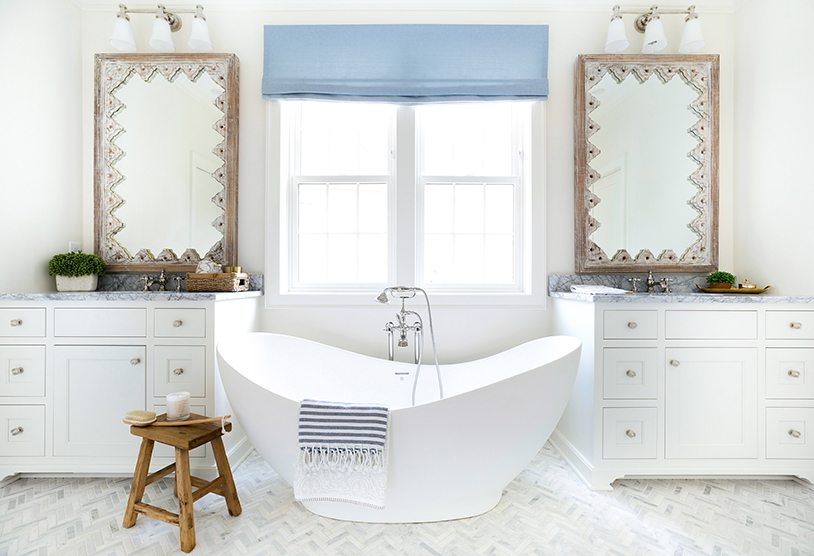
Bathtubs come in many different shapes, sizes, styles, and configurations. The two main types are freestanding tubs and built-in tubs. While built-in tubs are the most common and practical, freestanding tubs or soaking tubs are known for their striking visual impact. Want to know which one is right for you? Keep reading!
But first, the benefits of having a bath:
Regularly cleansing by submersing yourself in water helps to clear negative energy that you may have picked up during the day. Whether or not you know it, you come into contact with various people and environments, all of which have their own energy vibrations. Not all of these frequencies are high and positive.
Thus, your energy field is constantly taking in and putting out vibrations. While our energy body is constantly readjusting itself to bring our energy back into harmony, the negative energies can linger and build up over time. A monthly salt water bath is an easy and very relaxing way to cleanse of any negative energy and also it is super relaxing. A bath at night can help you to sleep better and reduce anxiety. Oh we love baths so much!
Now let’s move onto helping you find the perfect tub!
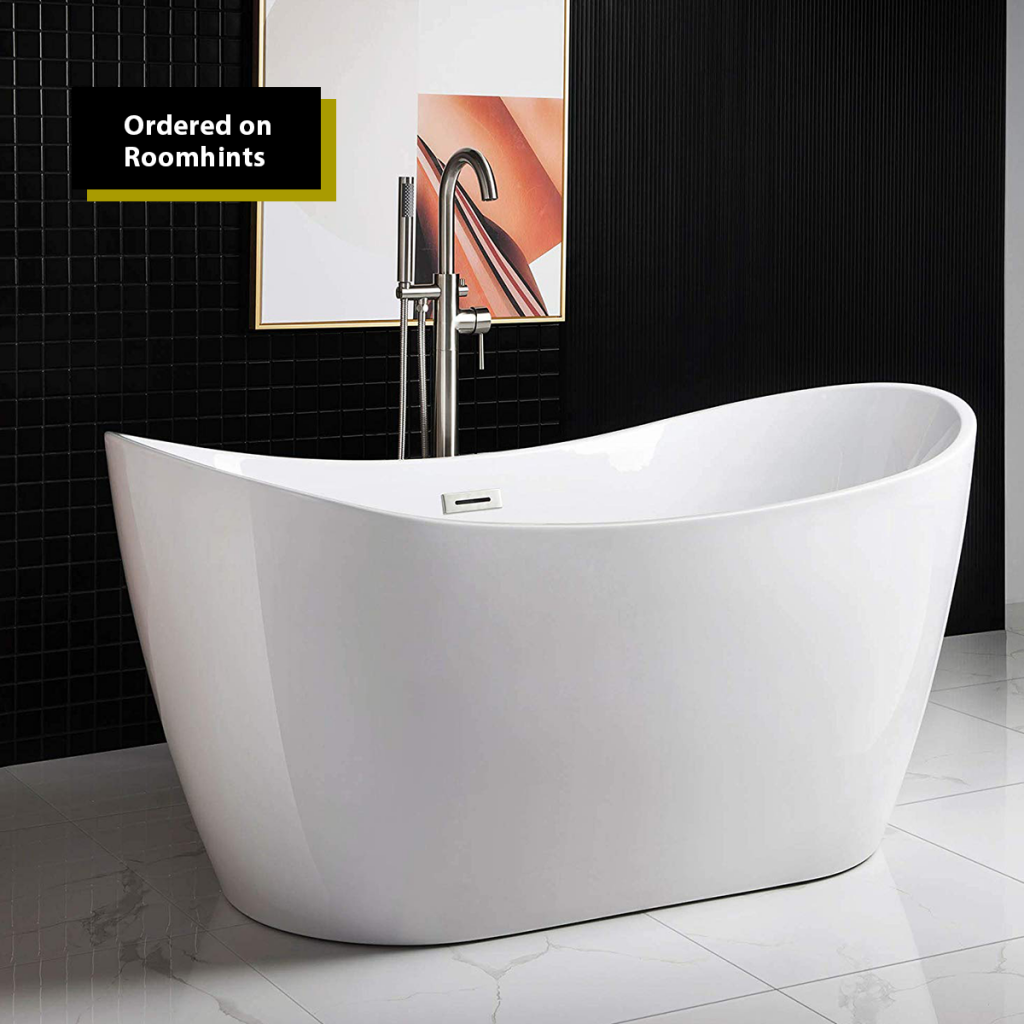
What is a built-in tub?
A built-in tub is installed against a wall, often within an alcove or enclosure, and looks like part of the room’s architectural design.
A drop-in tub is a built-in tub that is “dropped” into a surrounding enclosure, usually made of tile or another material like wood or marble.
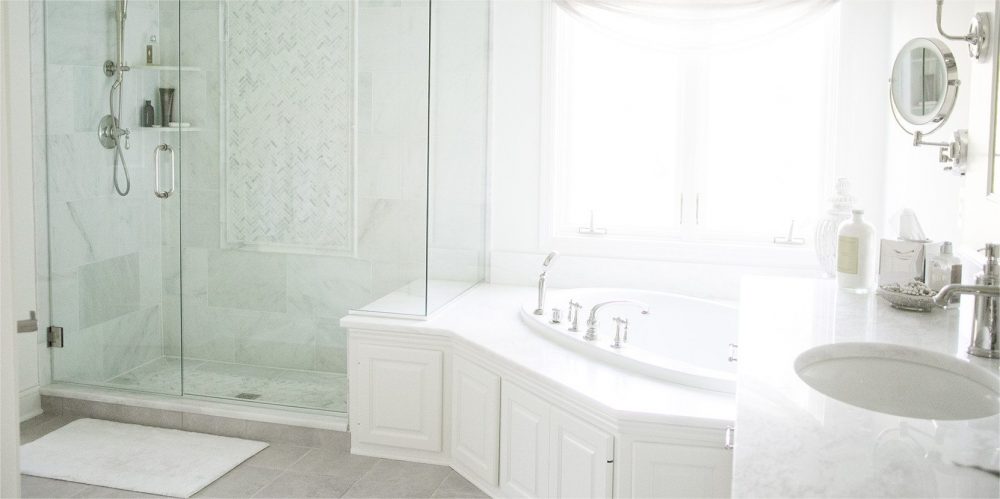
Designed by Bria Hammel Interiors
What is a freestanding tub or soaking tub?
A freestanding tub is exactly what it sounds like: a stand-alone tub that is exposed on the exterior on all sides. Freestanding tubs make a huge design statement and are perfect for people who love taking baths. A bold, eye-catching centerpiece, they add sophistication and luxury to any bathroom. They are known for their organic, modern shape, which add a sculptural element to the space. Nowadays, freestanding tubs come in a lot of different sizes, shapes, materials, and styles, both modern and vintage/traditional. Traditionally regarded as a high-ticket item, freestanding tubs have now become more widely available at various price points.
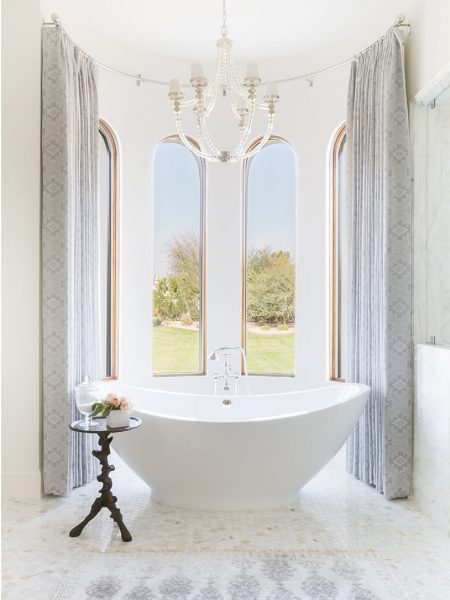
Designed by Bria Hammel Interiors
A famous version of the freestanding tub is the clawfoot tub. Contemporary models, however, usually sit flush on the ground. Another version of the freestanding tub is the Japanese soaking tub. Japanese soaking tubs are tall, deep tubs that are meant for sitting, not laying (they often incorporate a seat, as well). Traditionally made of wood, they now come in a wide variety of materials and add a cool twist to your bathroom.
Click the link for a more in-depth review of freestanding tubs.
Pros and Cons of a Soaking Tub
Pros of Soaking Tubs
Look:
The biggest perk of a freestanding tub is definitely its design impact and luxurious aesthetic.
Installation:
A freestanding tub is relatively easy to install — all you need is a plumber. You don’t need to build a framework around the tub, which saves time and money. A built-in tub, on the other hand, usually requires a decorator and a contractor. Installation is therefore easier and less expensive for freestanding tubs.
Placement:
Whereas a built-in tub needs to be placed against a wall, a freestanding tub can be placed anywhere as long as there is plumbing, allowing you to be more creative and flexible with placement and possibly allowing you to maximize your space and design. A freestanding tub is perfect if you want to place your tub under a skylight or against a window view.

Designed by Molie Malone
Cons of Soaking Tubs
Price:
Freestanding tubs are generally more expensive than built-in tubs because they are a high-ticket, luxury item.
Installation (Plumbing):
While installation is very easy once you’ve figured out the plumbing, figuring out the plumbing for a freestanding tub requires more planning than with a built-in tub because freestanding tubs often require new plumbing while built-in tubs often make use of existing plumbing. This is even more true if you want to place your freestanding tub in a less conventional spot, like in the center of your bathroom. Additionally, you’ll have to think about how to conceal plumbing for freestanding tubs.
Maintenance:
Freestanding tubs are more difficult to maintain and clean. The exposed exterior makes the basin more prone to staining, scratching, chipping, and cracking. You’ll also have to clean around and under the tub.
Functionality:
Most freestanding tubs do not come with a shower, which makes them impractical for daily use. If you want to mount a shower to your freestanding tub, you’ll also have to install a shower rod and wrap-around curtain, which is unsightly and impractical (think a wet shower curtain encroaching on your tiny bathtub space). On the other hand, a built-in tub allows you to combine a shower with a tub. With a built-in tub, you can get rid of the dreaded shower curtain altogether and install a glass door instead.
Storage:
Freestanding tubs have less storage because they do not have ledges or walls. Although having a clutter of shampoo bottles and shower products can look messy and undermine the luxury aesthetic of your freestanding tub, you can mitigate the lack of storage with innovative storage ideas or by placing a bathtub caddy or side table near your tub.
Space:
Because freestanding tubs are not flush against a wall and need to have space around them, they tend to take up more space. Soaking tubs are meant to be focal points, so placing them in bathrooms with inadequate space can make your space look cramped and can take away from the impact of your tub. Freestanding tubs are therefore difficult to install in small bathrooms, and are less common in urban homes and apartments which usually face space constraints.
Heat Retention:
Some people say that water in a freestanding tub cools faster because it is surrounded by air, whereas a built-in tub is insulated by the wall and sometimes a tile surround. You can mitigate this concern by choosing a material that retains heat better.


Designed by Bria Hammel Interiors
Pros and Cons of Built-In Tubs
Pros of Built-In Tubs
Price:
Built-in tubs are generally more affordable, although freestanding tubs have become more widely available at various price points and a built-in tub has additional costs of tiling and installation.
Space:
Built-in tubs are more space-efficient. They sit flush against a wall and are usually placed out of the way, while freestanding tubs need more space around them and occupy space a bit more awkwardly and less efficiently. If you have a small bathroom, a built-in tub is probably the best option for you because they make the best use of space.
Functionality:
Built-in tubs are more practical for daily use because you can incorporate a shower head into them. They also offer more storage for shampoo bottles.
Storage:
Surrounded by walls, built-in tubs offer more storage opportunities with shelving and recessed shower niches. You can also place shower products like shampoo bottles on the ledges of built-in tubs, and these ledges will have even more storage space if you opt for a drop-in tub with a surround tile.
Maintenance:
Built-in tubs are generally easier to clean because you do not have to clean around and under the exterior. They are also easier to clean because they are typically smaller, shallower, and come with a showerhead.


Designed by Crowell Interiors
Cons of Built-In Tubs
Look:
While it comes down to a matter of personal preference, a built-in tub simply does not make a statement the way that a freestanding tub does. A freestanding tub makes your bathroom look personal and customized while a built-in tub can tend to look like a standard builder’s basic tub. A drop-in tub compensates for the lack of unique design in a built-in tub, but a drop-in tub does not look as stylish, chic, or modern as a freestanding tub. Built-in or drop-in tubs both simply look dated compared to a freestanding tub.
Placement:
Because built-in tubs need to be placed against a wall, there is less flexibility with placement.
Installation:
Freestanding or soaking tubs are easier to install, despite the possible need for new plumbing. Built-in tubs require a designer and contractor, and require tiling and sealing.
Choice:
There are less design possibilities with a built-in tub, especially since most of its exterior does not show. There is a wider array of choices when it comes to freestanding tubs. Built-in tubs must therefore rely on their surroundings — the tile surround, the wall, and the overall bathroom aesthetic — to make an impact and look stylish.
Bottom Line: Freestanding Tubs and Built-In Tubs Compared
In sum, freestanding tubs are more stylish while built-in tubs are more practical. However, with the right design, a built-in tub can be just as impactful as a freestanding tub. Especially since there are so many options out on the market, you do not have to sacrifice style for practicality. A bathroom that works well — freestanding tub or not — is going to have the most value, aesthetically and practically. Let’s take a closer look at the comparisons between freestanding tubs and built-in tubs.

Image Credits: Studio Ore

Bottom Line: Is a freestanding tub or a built-in tub more practical?
A built-in tub is more practical all around because of its shower function, storage capacity, and maintenance requirements. If you want your tub to be more functional and plan on taking mostly showers, a built-in tub is the best option.
Of course, shower less freestanding tubs are only an issue if your tub is meant to be an all-purpose tub. If you are simply installing a freestanding tub for aesthetic purposes and already have a separate shower, then you won’t need to worry about the lack of function. You can also install a small hand-held shower for your freestanding tub for rinsing off. However, if you are making a choice between a freestanding tub and built-in tub with a shower, we would definitely recommend the shower.
Freestanding tubs are typically deeper so that you can completely immerse yourself in the tub, but that means the basin is higher and can be difficult to get in and out of. A tall freestanding tub can also pose a challenge for bathing children and pets. Again, this is only a concern if you don’t have a separate shower stall and your freestanding tub is your all-purpose shower.


Designed by Bria Hammel Interiors
Bottom Line: Is a freestanding tub or a built-in tub easier to install?
A free-standing bath tub is easier to install if you already have the plumbing figured out. A built-in tub needs to be built, tiled, and sealed into an existing structure, but makes use of existing plumbing.

Designed by Bria Hammel Interiors
Bottom Line: Is a freestanding tub or a built-in tub more expensive?
Freestanding tubs are generally more expensive because they are not only a more luxury item, but because they have an exposed exterior whereas a built-in tub usually only has one exposed exterior side. However, if you opt for a built-in tub or drop-in tub, the cost of the tiling, glass shower door, and contractor/designer may add to the overall cost of your built-in tub. While a freestanding tub may be more expensive initially, the cost of installation is significantly lower because they do not need to be built into a structure.

Designed by Regan Baker Design
Bottom Line: Is a freestanding tub or a built-in tub easier to clean?
It’s general consensus that a freestanding or soaking tub is harder to clean. You have to maintain the exterior, which is entirely exposed, and cleaning around and at the bottom of the exterior may be difficult, especially at the bottom where the basin meets the floor. It may also be hard to clean around the tub if it is placed near a wall without adequate space to maneuver around the basin. Moreover, cleaning a freestanding tub may be more time consuming because there is typically no shower head to help you clean (on a regular basis and for more intensive cleaning). Overall, a freestanding or soaking tubs is more difficult to clean because you’ll have to clean around and under it (if you have a clawfoot tub).
On the other hand, you’ll have to clean the walls of a built-in tub, and this may be more difficult especially if you have bathroom tile and lots of grout lines. The same applies to the tile surrounding if you have a drop-in tub.
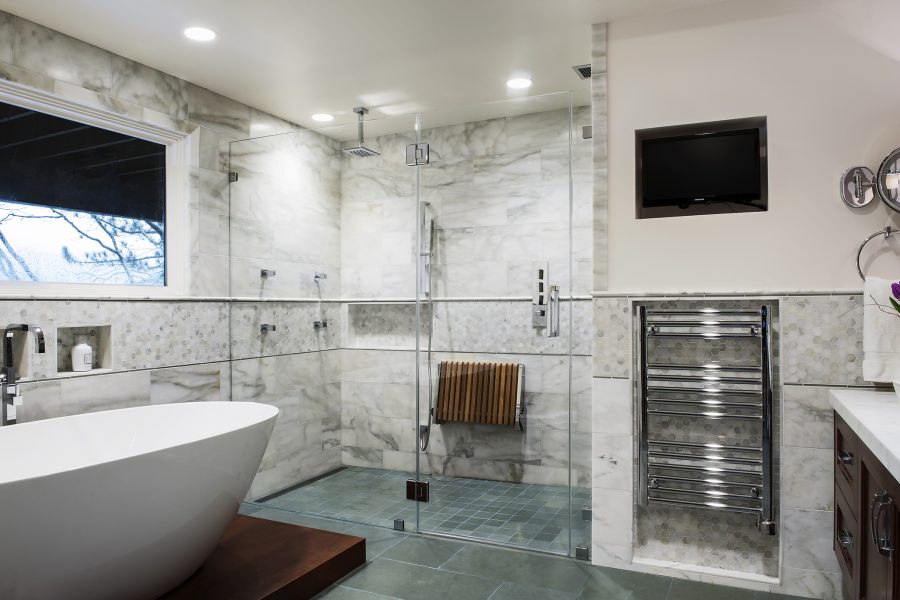

Designed by Studio SHK
Can I switch my built-in tub for a free standing tub and vice versa?
As with any tub installation, you’ll have to consider structural constraints and plumbing requirements. You’ll have to consult a plumber to determine if it is feasible. However, since built-in tubs and free standing tubs typically require a lot of planning with regards to plumbing, space, and plumbing/structural requirements, the short answer is probably no: unless you’re doing an entire bathroom remodel, switching out your tub won’t be a quick and easy (or affordable) swap.
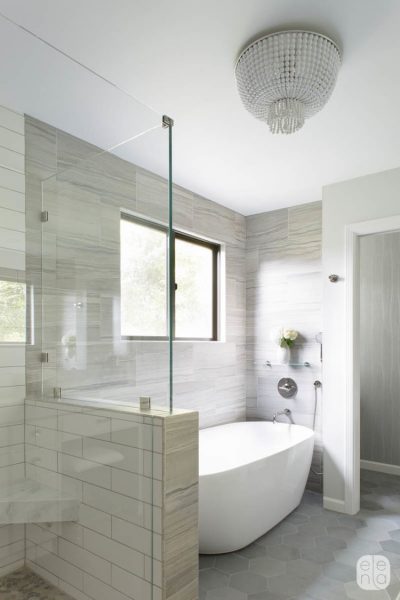
Designed by Elena Calabrese
What About Walk-in Tubs?
A walk-in tub is a bathtub with a watertight door that allows you to step into the tub. It is much easier and safer than getting into a regular tub. The door closes, the tub fills with water and after draining the bath, the person opens the door and steps out safely.
While many models are taller than they are wide, there are many different models and configurations available to meet the needs of almost every customer and housing situation.
Walk-in Tub Comfort
- Pro: Water Depth Because there is no need to step over a tall wall, walk-in tubs provide a deeper water depth when compared to traditional tubs. A standard bathtub has a depth of 13 to 14 inches, while walk-in tubs can allow for up to nearly four feet of water depth for a comfortable immersion experience while seated securely.Seats are generally placed at 17 inches high, leaving almost 20 inches of depth to immerse the torso, well within the average torso length of an adult. Many walk-in tub models also have hydrotherapy jets available and other luxury features such as chromotherapy, lighting and heated seating.
- Con: Time to Fill and Drain Since a walk-in tub has a door in the side of the tub itself, you cannot add or drain water while the door is open. This means you’ll spend a considerable amount of time sitting in the tub while waiting for it to fill as well as time waiting for it to drain before you can exit the tub. Some soaking tubs can take as long as 15 minutes to fill or drain, although some high-end models have features to speed up this process. Even with rapid fill and rapid drain features, walk-in tubs can average around eight minutes to fill or drain, leaving a significant amount of time where much of the body is exposed to air and can become chilled. One possible way to reduce chilling is to purchase a model with a heated seat.
Walk-in Tub Safety
- Pro: Safety Features Much of the remodeling suggested for aging in place revolves around safety, specifically preventing falls. Over one-third of adults over age 65 fall each year and over 80 percent of those falls are in the bathroom. Walk-in tubs generally provide an array of features designed to reduce falls. These often include built-in handrails, an ADA compliant overall design, anti-slip flooring, contoured built-in seating, and a low step height for entry.Some models also include wide doors designed to allow those in wheelchairs to transfer easily to the tub seat without assistance. Another safety feature, although not related to falls, is a scald prevention valve, designed to prevent hot water burns.
- Con: Temperature Another concern with a walk-in tub is temperature. Since you must enter the tub before filling it, there is no chance to adjust the water and get it just right before exposing your body to the water. Also, because you must sit in the tub while it fills, it is very easy to become acclimatized to dangerous temperatures as the water slowly climbs. Because of this, it is important that any tub you consider be equipped with a scald prevention valve that is designed to prevent dangerously hot water from entering the tub. Even then, it could take some uncomfortable minutes to get the water temperature adjusted comfortably in the tub as it fills.
- Con: Price After installation the walk-in tub can cost anywhere from $5000 – $10,000.
The Best of Both Worlds: Walk-In Shower
Some people ask, function or form? We answer: Why not both? Truth be told, it is quite rare that we see bathrooms with freestanding tubs without a walk-in shower. Freestanding or soaking tubs are simply not practical to provide for all of your everyday needs. Having both a bathtub and a walk-in shower allows you to have the aesthetic and practical advantages of both.

Designed by Jen Talbot Design
Bottom Line: Which is better? Freestanding soaking tub or built-in tub?
Ultimately, it is up to you to decide which option is best for your needs, wants, bathroom space, and lifestyle. However, the choice essentially comes down to the practicality of built-in tubs versus the luxury and design of freestanding or soaking tubs. The bottom line is this: Only go for a freestanding tub if you have the space for it and if you really, truly want one (and will actually use it often!), and, in our opinion, if you also have the space for a walk-in shower. The ideal solution is to have a freestanding tub along with a separate shower stall so that you have the best of both worlds.
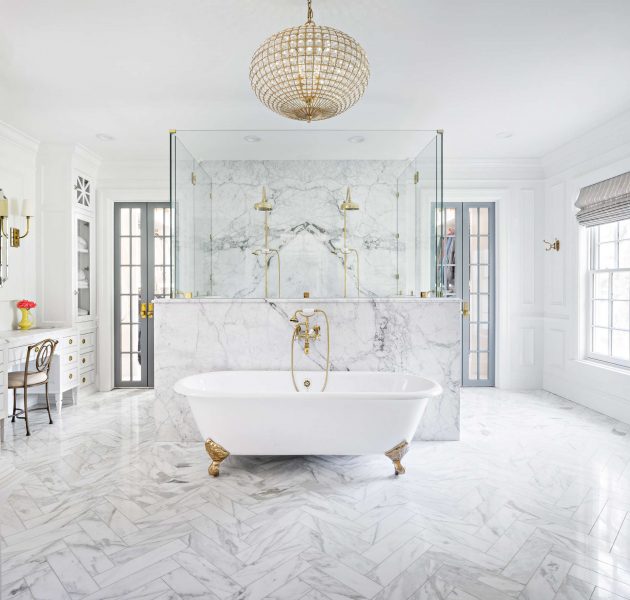
Designed by The Fox Group
For more bathroom design hints check out our Guide to Freestanding bathtubsBuying Guide: How to Choose a Freestanding Tub, 4 hints for a small bathroom or our stunning pink tile bathroom hints.







